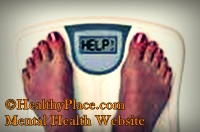Help for Adult Women with Eating Disorders

Many adult women have eating disorders. Discover how eating disorders therapy works and how to engage in healthy eating.
Most everyone thinks of anorexia, bulimia, and other eating disorders as conditions only young women face, but new evidence shows that many women over 35 suffer from these afflictions throughout their lives.
When I was about 14 years old and just beginning my initiation into the mysterious rites of passage toward becoming a woman, one of the very first "secrets" I learned was how to diet. Here was a way, or so I thought in my innocence, that I could eat whatever I wanted and make up for it later by dieting it all off. How clever were these older women who taught us youngsters how to have our cake and eat it too! As it turned out, not only did I enjoy dieting, with all its deprivations and strict rules, but I had a real talent for it. When I embarked upon a diet, my willpower was resolute and unshakable. But when the diet was over and I'd reached my preferred number on the scale, I couldn't wait to run into the kitchen and start scarfing down all the foods I'd forbidden myself during the diet. That was how I discovered firsthand what so many women have known throughout the ages—forbidden fruits do taste sweeter.
Dangerous Hidden Secrets of Dieting
By the time I'd gotten older, into my late 20s and early 30s, this routine, which had started out as an innocent game, had developed sinister overtones. Now I know the name for what I was doing: yo-yo dieting, which is the practice of losing pounds and regaining them over and over again, moving up and down in weight like a spinning toy on a string. I managed to keep my weight more or less stable into my 40s using this method—it just meant I was perpetually on a diet.
When I looked around at most of the women I knew, both older and younger, I saw a secret society whose members seemed to have the same unspoken agreement (which I personally didn't recall signing) that looks counted above all else. And I realized that the wish I'd long been secretly harboring—that there would be some age limit on this crazy way of looking at food and my body, some point at which I would finally be old enough to opt out of the whole insanity—was not going to come true. I was going to either have to find my own way out or this could easily go on for the rest of my life.
I now know that I was hardly alone in continuing to face serious food and body issues well into midlife. Conventional wisdom in the medical community used to posit that eating disorders were something that happened only to younger girls, and that most women in their mid-30s would certainly have outgrown them. But now those who specialize in the treatment of eating disorders have come to understand that there is no age limit. Eating disorders can and frequently do occur in women that age and beyond. In fact, for the most part, as happened with me, these are eating disorders that women developed as adolescents or young women and never resolved.
This new definition of eating disorders as a condition that can affect any woman at any age may come as a huge relief to the leagues of older women who thought they were all alone, suffering from a disorder they should have outgrown. The good news? When it comes time for treatment, older women bring a mature perspective on life and a resourcefulness to the process that younger women don't yet possess.
 Defining eating disorders
Defining eating disorders
The most common eating disorders include anorexia nervosa—in which a person consumes too little food and suffers extreme weight loss—and bulimia—in which a person repeatedly forces herself to vomit after eating, typically after binge eating. Bulimics may also use laxatives to purge themselves. A more general category is binge eating disorder, which, according to Diane Mickley, MD, director of the Wilkins Center for Eating Disorders in Greenwich, Connecticut, shares features with bulimic behavior, such as binging, placing too high a value on food and body issues, and having increased anxiety around food. The general category known as "EDNOS" (Eating Disorders Not Otherwise Specified) includes a wide variety of eating behaviors that don't otherwise have a name but have one thing in common: spending an inordinate amount of time and energy obsessing about food and body. Overexercising, overemphasizing thinness, obsessive thinking, repeated "cleansing," yo-yo dieting, and other forms of excessively restricted eating fall into this catchall category.
One of the worrisome new eating disorders to which women in midlife and beyond may be especially susceptible is orthoexia nervosa, which is defined as a "fixation on righteous eating." This occurs when an obsession with healthy eating begins to dominate a person's thoughts and life to the point where the behavior itself becomes unhealthy. According to Tacie Vergara, clinical supervisor at the Renfrew Center's Thirty-Something and Beyond Group (an inpatient eating disorders program in Philadelphia and other East Coast locations), orthoexia "can start for older women when they've got a life crisis—fear of mortality, a cancer diagnosis, or maybe their husband just got diagnosed with a cardiac problem," Vergara explains. "It starts out as a healthy impulse to eat better, but before you know it, it's out of control."
Whatever the eating disorder, experts agree that most of these conditions don't just come out of nowhere in midlife. "The vast majority of affected people have their first onset in adolescence," says Mickley. "Some may have had longtime food and weight concerns; they may have had low-grade problems that hid out under the radar for a long time. But it's extremely rare for an eating disorder to manifest for the first time in middle age."
Most afflicted women manage to cope for years with the many different forms of eating disorders, and many of them don't even realize that they're suffering from one.
"It didn't dawn on me I had any kind of eating disorder until I was in my 30s," says Karen Franklin, a woman who has struggled off and on with anorexia since she was a young girl. "I thought that I was just some kind of freak around food—I didn't know how to nourish myself. But then I came across some articles on anorexia, and I had an amazing awakening that I was like those girls."
Franklin thought her problem was behind her until she saw her child develop an eating disorder of her own. "I felt like I had things under control—my life felt really full—but when my daughter started having eating problems, something really clicked for me," Karen recalls. "All my old body issues came tumbling back."
Sorelle Marsh also saw her long-standing eating disorder spin out of control in midlife. "I started out as an anorexic when I was about 17 or 18," Marsh explains. "But then I learned about bulimia, and I thought, 'Wow, this is a great way to have it all and still be thin!'" Marsh says the bulimia continued off and on until, at age 41, she found it increasingly difficult to hide her behavior from her husband and children. She went to see a therapist who gave her some drugs to help with her anxiety and depression. However, the drugs sent her into a suicidal depression.
"I was very depleted in every way, shape, and form from the binging and purging," says Marsh. "I thought to myself, 'You can't go on like this,, you need help,' and I decided that I needed to go somewhere, away from my life, to get help."
According to Mickley, eating disorders reassert themselves in midlife for myriad reasons. "Number one is if you feel that your self-worth is heavily based on your appearance, as you get older it inevitably means the loss of your youthful appearance," she says, "and there are so many other kinds of losses that can occur in midlife, such as the end of a relationship or a divorce, the stress of remaining in an unhappy relationship, or a medical illness. There are also so many issues around kids—kids growing up, kids with problems, or kids going off to college."
Whatever the cause of a relapse, the number of women over 35 seeking help for eating disorders is rapidly increasing. According to Vergara, from 1985 to 2000 approximately 3 to 5 percent of those seeking treatment at the Renfrew Center were over 35. From 2003 on, that number skyrocketed to 30 percent. Vergara credits this in part to Renfrew creating a special program called the Thirty-Something and Beyond Group. "We'd always served these women but never specifically targeted them before," Vergara explains. "Once we gave them permission and let them know there was a place for them to come, they were there waiting and hungry for our services."
Getting help for an Eating Disorder
Eating disorder clinics and specialists generally don't use any special therapeutic tricks when treating older women with eating disorders. The same techniques and approaches work with younger and older women alike. "In treating eating disorders in general, one of the common myths is that there are underlying psychological problems, you work them out, and the illness will evaporate," says Mickley. "But it's the reverse. If you have an eating disorder, you must first manage food, weight, and eating symptoms if you want to do good work in therapy. The notion that you'll take someone who is throwing up all day and build her confidence makes no sense—that act of vomiting provides her with emotional Novocaine, and if you numb your feelings, how are you going to learn what you feel? So the first line of defense in folks of all ages is symptom management."
Still, peer-group programs work especially well for women in midlife. "These women have lost so much in midlife that they're not going to get back," says the Renfrew Center's Vergara. "So we have groups specifically geared for their unique life situations, such as how do you be a mom on the go and also provide sound nutrition for you and your family, how do you learn to care for yourself as well as others, and all the unique issues that come up over not being fed and being out of balance in midlife."
The Renfrew program has given Marsh a new outlook on life, food, and her own journey. "The first thing the Renfrew program did for me was get me out of my home and environment and stop the binging and purging," Marsh recalls. "I knew my time at Renfrew was my only and last chance. It causes me a lot of sadness that I couldn't have done this when I was 20 or 25 or any other time—but I've realized this is now my time to do it."
For all of us working with eating issues in midlife, it's important above all to remember that each of us is a work in progress. Life will continue to change, with new challenges, new joys, and new wrinkles—including those that line our skin. The point isn't to get it all figured out once and for all and rest on your laurels. Rather, you can achieve many levels of success and many levels of satisfaction. Waking up to all of the richness that life can offer when you are conscious can help you heal your eating disorder, as well as live a life with purpose and passion.
Moving Into Healthy Eating
When I realized that I no longer wanted to spend my days obsessing about food and body, I had no idea how to go about making that change. At this same time I began to do yoga and to meditate. I found that both practices increased my ability to be conscious—not only around food—but also of seeing the kind of habitual thoughts that were etched deep in the recesses of my mind. When I ate consciously, it was very hard to accidentally eat a bag of cookies and wonder where they might have gone to, which enabled me to control my eating without even trying. And consciousness also proved to be the key for actively identifying what held meaning for me in life.
Mind/body practice, such as yoga, tai chi, meditation, or mindful walking can help a person who is struggling with any form of eating disorder learn consciousness in motion. This can directly impact the way one eats, since mind/body practices help us listen to what we're truly hungry for on our physical, emotional, and spiritual planes.The key is to use the mind/ body practice as a tool of self-discovery and as a means to develop consciousness—not as one more opportunity to beat yourself up about what a lousy meditator you are or how bad you look in your yoga outfit.
"Yoga brought me to a place where I could like myself without looking in the mirror," says Karen Franklin, who's struggled with anorexia for years. "It was so clear to me that yoga is about non-judgment and self-reflection, but it's also about action—I act, and then I can let it go. For me yoga is always a fresh start—I messed up today and tomorrow will be better. That's a very different point of view from when I used to think, 'I messed up today, and tomorrow I won't eat.' It's brought me a certain amount of wisdom around my actions and has also helped me discover what will nourish me."
Awakening Conscious Eating
The following practice introduces you to some basic techniques for conscious eating. The seemingly simple act of having the intention to stay conscious as you eat and to maintain attention to the process of eating can completely alter your relationship with food. It will help you break food patterns that may otherwise feel all-powerful, overwhelming, destructive, and out of control.
The following practice introduces you to some basic techniques for conscious eating. The seemingly simple act of having the intention to stay conscious as you eat and to maintain attention to the process of eating can completely alter your relationship with food. It will help you break food patterns that may otherwise feel all-powerful, overwhelming, destructive, and out of control.
- Start out by selecting a food that you enjoy, both for its appearance and taste, but that doesn't hold conflict for you in any way. Place the food on the table and sit facing it. Take a moment to clear your mind and drink in the appearance and aroma of the food.
- Before you eat, set the intention to focus your complete attention on the first and last bites of the food and to note any feedback you receive as you eat. This sounds deceptively simple. Don't be surprised if it's challenging!
- As your teeth sink into the first bite, try to slow down the moment so you experience it fully and consciously. When you finish chewing the bite, savor the sensations, and listen to any feedback you may experience.
- For the rest of the food, just eat as you normally would, but as you prepare to finish the last bite, repeat the previous exercise, trying to focus all of your attention and to remain fully conscious.
After you've finished eating the food, take just a moment to reflect. Consider what percentage of the time you were conscious in between the first and last bites and what percentage of the time your thoughts were elsewhere. Did setting your intention to remain conscious for the first and last bites make you more conscious in between, or just for those bites?
Repeat this simple food practice once a day for a week. You may eat the same food or choose different foods each time. You'll probably notice that the amount of time you spend between bites being consciously aware of your food and the eating experience will increase gradually over the week.
Source: Adapted from the book, What Are You Hungry For? Women, Food and Spirituality, by Lynn Ginsburg and Mary Taylor (St. Martin's Press, 2002).
APA Reference
Staff, H.
(2008, December 29). Help for Adult Women with Eating Disorders, HealthyPlace. Retrieved
on 2025, November 29 from https://www.healthyplace.com/alternative-mental-health/eating-disorders-alternative/help-for-adult-women-with-eating-disorders


